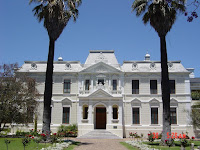In 1983 Dirkie Smit (a respected South African theologian from Stellenbosch) wrote that especially in German circles, there are still intense discussions about the so-called ‘origin of the Easter faith.’ Integral to these discussions are always the question of whether the empty tomb of Jesus can be seen as a condition sine qua non for genuine resurrection faith.
How did Smit respond to this? “To say that the idea of the empty tomb is unnecessary and actually even a stumbling block for the real Easter faith is to deny this historical – and reality motif” [1]
On 31 January 2011, Smit delivered a paper at the Stellenbosch University Theological Day entitled: The resurrection of Jesus: a theological orientation (Die opstanding van Jesus: ‘n Teologiese oriëntering). He starts off with the following striking paragraph:
"... the gospel is the gospel of the resurrection of Jesus Christ. That's the message. That's the good news. It's the content of faith. The church exists because of the resurrection. All functions of the church rests on the resurrection. Without the resurrection of Jesus Christ, nothing which believers say or do, profess or practice makes any sense."
What does he say about the empty tomb of Jesus?
"The good news, the wonder, the mystery is that God raised Jesus from the dead. God raise Jesus from the dead and make Him Lord and Christ, not anyone, but this Jesus, the Crucified – this is how the content of the first preaching in the book of Acts (Acts 2:36) sounds. The wonderful and surprising point is not that someone who was dead conquered death, but that this very Jesus is being resurrected.
This is the theological meaning of both the reports of the empty tomb and the reports of the appearances of the Resurrected."
The Afrikaans paper can be viewed here: http://www.soliustitiae.co.za/insights/2011/02/03/die-opstanding-van-christus-%E2%80%98n-teologiese-orientering/
Will be nice to hear some responses from people who attended day!
* I’ve tried my best to make a literal translation of the Afrikaans but suggest that readers have a look at the original please.
* I’ve tried my best to make a literal translation of the Afrikaans but suggest that readers have a look at the original please.
[1] My translation, see Smit DJ 1983. Prediking in die Paastyd, in Riglyne vir Paas-, Hemelvaarts- en Pinksterprediking. Woord teen die Lig 3. NG Kerk- Uitgewers, pp18-30.



4 comments:
Amen, Hy het waarlik opgestaan. Om hierdie historiese feit te snap het jy openbaring in hart nodig(vry van enige dogma of teologiese denkrigtings). Met 'n verkeerde geestelike bril op sal jy dit nooit snap nie, in teen deel dit sal net heel tyd bokant jou onbegryplike denke bly.
Hi Stephan my neef,
Wonderlik om van jou te hoor. Dis wonderlik om te hoor dat daardie Jesus wie se graf leeg is ook in jou hart lewe.
I just read on the website of the Dutch Reformed Church Newspaper (called Kerkbode) a short report of the meeting in Afrikaans. I've tried to translate it:
The resurrection is the heart of the Christian faith. Without the resurrection, the Christian faith does not exist. The church exists because of the resurrection. All functions of the church rests on the resurrection.
This is what Prof. Dirkie Smith of the Faculty of Theology at Stellenbosch University said during the annual theological Day. This year's theme was "the resurrection and the life."
Rev Danie du Toit of the DR Church Waterkloof in Pretoria, talked about the different ways in which artists portrayed the resurrection story through the. He said just as theology has grown and changed through the centuries, so also has artist's depictions of Christ changed.
During question time, Smith said that according to the New Testament, Jesus' resurrection was not simply the return of a body that once was dead, it was much more. His resurrection was clearly different from that of Lazarus, with profound theological implications. Both the reports of the empty tomb and the reports of the various appearances of Jesus show both continuity and discontinuity. It was indeed the same Jesus who was resurrected, but different from how they knew him previously - both these aspects the disciples had to discover and both are of vital importance for faith.
Someone in the audience said there should be greater clarity about what is meant when we say the resurrection is metaphorical. Prof Smith said it is not the resurrection that is metaphorical, but our language. The resurrection was real, but as Paul explains in 1 Corinthians 15, we do not have the necessary words and concepts to understand and articulate this reality, Professor Smith said. The language which the Church use to speak about the resurrection of Jesus, is like all theological language, also with regards to the incarnation, crucifixion, holy communion and the living presence of Christ, metaphorical, human language about a spiritual reality. He therefore pleaded for great modesty when believers disagree about the best terms to use when we think about faith realities, because we are speaking about things of which we really know nothing, as Paul also makes clear. Debates about the resurrection is therefore often unnecessarily divisive, Prof Smith said.
I attended the day and the discussion afterwards. It was not clear whether Smit understood a literal death of Jesus or a literal, physical ressurection. In the discussion afterwards, he rejected the "immortality of the soul" that he views as a Greek idea. So it was also not clear how he understood the resurrection of the dead (believers) or eternal life.
Post a Comment